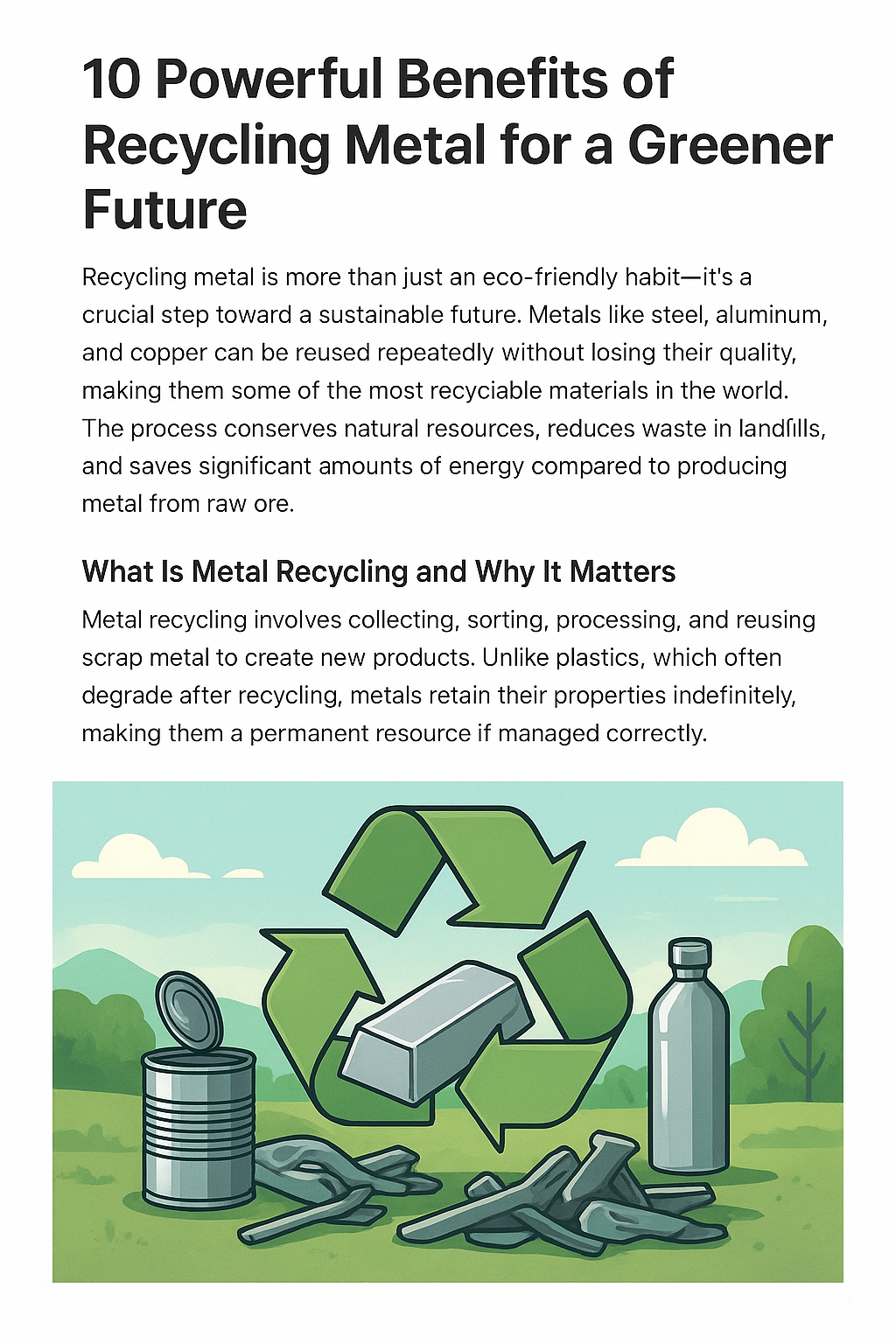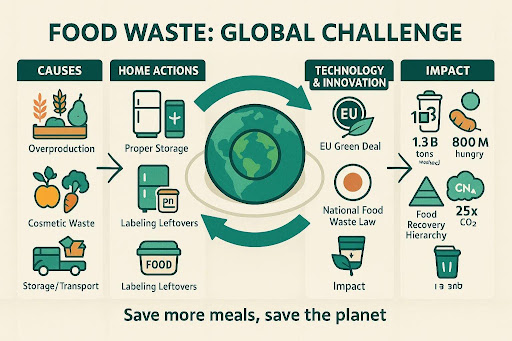
Food Waste Diversion Strategies That Transform Communities: Effective Solutions for Businesses and Environmental Impact
By BKThemes
Every year, North American businesses send over 130 billion pounds of food scraps to landfills, driving up disposal costs and accelerating methane emissions. In this guide, readers will discover proven food waste diversion strategies, learn how evolving regulations shape compliance, explore economic and environmental benefits, and gain practical steps for implementation. It also maps out National Waste’s tailored dumpster rental solutions, highlights community impact, and answers the most pressing operational questions.
Food Waste and Landfill Impact
North American businesses send a substantial amount of food waste to landfills annually, leading to increased disposal costs and the emission of methane. This waste stream contributes significantly to environmental concerns, highlighting the need for effective diversion strategies to mitigate these impacts.
United States Environmental Protection Agency (EPA), “Reducing Food Waste & Packaging” (2024)
This source provides context on the scale of food waste and its environmental consequences, which supports the article’s introduction.
What Are the Key Food Waste Diversion Strategies for Businesses?
Food waste diversion strategies encompass methods to capture organic materials before they enter landfills, reducing environmental impact and cutting disposal costs. Companies can implement multiple approaches—each with unique mechanisms and community benefits—to transform waste streams into valuable resources.
Before exploring individual tactics , it’s helpful to see how these methods compare:
| Method | Key Attribute | Outcome |
|---|---|---|
| Composting | Biological decomposition | Produces nutrient‐rich soil amendment |
| Anaerobic Digestion | Oxygen-free bioconversion | Generates biogas for energy and digestate for fertilizer |
| Food Donation | Surplus redistribution | Feeds vulnerable populations and reduces landfill waste |
| Animal Feed | Feedstock repurposing | Supplies protein-rich feed and diverts organic scraps |
| Waste-to-Energy | Thermal conversion | Recovers heat and power from residual organics |
Each strategy can be layered for maximum diversion and community benefit. Next, these core methods are examined in detail.
How Does Commercial Composting Reduce Food Waste ?
Commercial composting transforms organic kitchen and production scraps into stable compost through controlled aerobic decomposition. By diverting food waste to composting facilities, businesses reduce landfill fees and produce soil enhancer that supports local agriculture. Key benefits include: food waste
- Improved waste volume reduction by up to 90 percent.
- Elimination of methane emissions associated with anaerobic landfill conditions.
- Generation of a marketable soil amendment that closes nutrient loops.
Benefits of Commercial Composting
Commercial composting offers significant advantages, including a reduction in waste volume, the elimination of methane emissions, and the creation of a marketable soil amendment. These benefits contribute to both environmental sustainability and economic savings for businesses .
The Composting Council, “What is Compost?” (2023)
This citation supports the article’s claims about the positive outcomes of composting as a food waste diversion strategy.
Composting’s nutrient recovery sets the stage for energy-focused methods like anaerobic digestion.
What Role Does Anaerobic Digestion Play in Food Waste Management?
Anaerobic digestion uses microorganisms in sealed reactors to break down organic matter without oxygen, producing renewable biogas and nutrient-rich digestate. This process reduces waste volumes, offsets fossil fuel use, and returns valuable byproducts to farms. Its dual‐output mechanism—energy and fertilizer—reinforces a circular economy and lowers carbon footprints.
Extending from energy recovery, surplus food donation offers a direct social benefit.
Every year, North American businesses send over 130 billion pounds of food scraps to landfills, driving up disposal costs and accelerating methane emissions. In this guide, readers will discover proven food waste diversion strategies, learn how evolving regulations shape compliance, explore economic and environmental benefits, and gain practical steps for implementation. It also maps out National Waste’s tailored dumpster rental solutions, highlights community impact, and answers the most pressing operational questions.
Food Waste and Landfill Impact
North American businesses send a substantial amount of food waste to landfills annually, leading to increased disposal costs and the emission of methane. This waste stream contributes significantly to environmental concerns, highlighting the need for effective diversion strategies to mitigate these impacts.
United States Environmental Protection Agency (EPA), “Reducing Food Waste & Packaging” (2024)
Thi
How Can Food Donation Programs Support Community Food Waste Diversion?
Food donation programs rescue edible surplus from commercial kitchens and divert it to local food banks and shelters. By partnering with certified receivers under safe handling guidelines, businesses minimize waste, qualify for tax incentives, and strengthen community resilience. This approach alleviates hunger while meeting corporate social responsibility goals.
Food Donation Programs and Community Impact
Food donation programs play a crucial role in diverting edible surplus from commercial kitchens to local food banks and shelters. This approach not only reduces waste but also addresses food waste , aligning with corporate social responsibility goals and strengthening community resilience.
Feeding America, ” Food Waste ” (2024)
This citation supports the article’s discussion of food donation programs and their positive impact on communities.
When edible options diminish, animal feed conversion provides the next level of diversion.
What Are the Benefits of Using Food Waste for Animal Feed?
Converting post-processing scraps into animal feed repurposes leftover produce into high‐value livestock nutrition. This method reduces disposal costs, supplies affordable feedstock, and closes the resource loop. Compliance with feed safety standards ensures both animal welfare and environmental stewardship.
For residuals unsuitable for compost or feed, thermal methods complete the suite of options.
How Does Waste-to-Energy Fit into Food Waste Diversion?
Waste-to-energy incineration combusts residual organic matter to generate steam or electricity, capturing energy that would otherwise be lost. While less preferred due to capital intensity, it provides a final diversion path for inedible or contaminated waste fractions and contributes to grid stability .
These five strategies provide a foundation for compliance—next, we explore regulatory drivers across North America.
How Do Food Waste Regulations Drive Diversion Efforts Across North America?
Food waste regulations establish mandatory diversion targets and reporting requirements that compel businesses to adopt sustainable disposal practices. By linking legal compliance to environmental outcomes, regulations accelerate adoption of composting, donation, and recycling programs. Food waste
Regulations and Food Waste Diversion
Food waste regulations, such as those in California and Massachusetts, mandate diversion targets and reporting requirements, compelling businesses to adopt sustainable disposal practices. These regulations drive the adoption of composting, donation, and recycling programs .
California Department of Resources Recycling and Recovery (CalRecycle), “SB 1383: Short-Lived Climate Pollutants” (2024)
This citation supports the article’s discussion of the role of regulations in driving food waste diversion efforts.
Understanding regional mandates helps businesses design effective diversion plans.
What Are the State-Specific Food Waste Mandates Businesses Must Know?
Below is a summary of key state-level requirements that large businesses must meet:
| Regulation | Jurisdiction | Requirement |
|---|---|---|
| SB 1383 | California | 75 percent diversion by 2025; mandatory composting |
| Massachusetts 310 CMR | Massachusetts | Ban on disposal of source-separated organic materials |
| NYC Local Law 146 | New York City | Weekly organics collection for large generators |
| NJ A 4740 | New Jersey | Phased organics ban for institutions and chain stores |
These mandates shape corporate diversion strategies and inform audit processes.
How Do Federal Policies Like the Bill Emerson Good Samaritan Act Affect Food Waste Diversion?
The Good Samaritan Act protects donors from liability when donating to nonprofit organizations, encouraging businesses to give edible surplus rather than discard it. This federal safeguard complements state donation mandates and amplifies redistribution efforts.
With regulations in mind, a formal compliance checklist guides large enterprises.
What Is a Compliance Checklist for Large Businesses Managing Food Waste ?
A practical compliance checklist includes:
- Conducting a baseline food waste audit and documentation.
- Establishing source-separation protocols for organics.
- Partnering with certified composters or donation agencies.
- Scheduling regular diversion pickups to meet local mandates.
- Maintaining records to demonstrate compliance and report metrics.
This structured approach prepares businesses for audits and regulatory reviews.
How Does National Waste Help Businesses Meet Food Waste Regulations?
National Waste provides turnkey compliance support by supplying dedicated organic dumpsters, coordinating tailored pickup schedules, and delivering diversion reports. Their service ensures businesses meet state mandates, avoid fines, and demonstrate sustainability leadership.
Building on regulatory drivers, the next section reveals the bottom-line and ecological advantages of diversion .
What Are the Economic and Environmental Benefits of Commercial Food Waste Diversion?
Beyond compliance, food waste diversion yields cost savings, reduces greenhouse gas emissions, enhances brand reputation, and unlocks resource recovery opportunities. Each benefit contributes to a stronger bottom line and healthier communities.
How Does Diverting Food Waste Lead to Significant Cost Savings?
Diverting organics cuts landfill tipping fees and hauling expenses. Typical savings per ton diverted can exceed waste disposal costs by 20–30 percent. The table below illustrates potential financial impact:
strategic waste diversion business cost savings
| Expense Category | Before Diversion | After Diversion | Annual Savings |
|---|---|---|---|
| Landfill Tipping Fee | $100 / ton | $20 / ton | $80 / ton |
| Hauling & Logistics | $50 / ton | $40 / ton | $10 / ton |
| Total | $150 / ton | $60 / ton | $90 / ton |
These direct savings improve ROI and fund further sustainability investments.
How Does Food Waste Diversion Reduce Methane Emissions and Carbon Footprint?
By removing organics from landfills, businesses prevent anaerobic decomposition that emits methane—a gas 25 times more potent than CO₂ over 100 years. Composting and anaerobic digestion convert waste into safe byproducts, shrinking carbon footprints and supporting climate goals .
Reducing emissions dovetails with brand and stakeholder expectations .
How Can Food Waste Diversion Enhance Corporate Social Responsibility and Brand Reputation?
Sustainable diversion programs signal environmental leadership, attract eco-conscious customers, and support community partnerships. Publicizing diversion metrics and donation volumes strengthens brand image, fosters employee pride, and distinguishes businesses in competitive markets. Diversion strategies can play a crucial role in achieving these outcomes.
These reputational gains create new opportunities for resource reclamation .
What Are the Resource Recovery Opportunities in Food Waste Diversion?
Food waste diversion unlocks multiple resource streams: Food waste
- Compost for agriculture and landscaping.
- Biogas for on-site power generation.
- Animal feed for local livestock operations.
- Digestate as a nutrient-rich soil amendment.
By closing resource loops, businesses contribute to a resilient circular economy .
With benefits established, the next logical step is designing an effective diversion program .
How Can Businesses Implement an Effective Food Waste Diversion Program?
An effective program begins with measurement, engages staff, optimizes operations, and leverages technology for tracking. This structured approach ensures sustainable results and continuous improvement.
What Is the Process for Conducting a Food Waste Audit?
A food waste audit identifies quantities and sources of discarded organics. Steps include:
- Defining audit scope (pre-consumer vs. post-consumer).
- Collecting and categorizing waste over a representative period.
- Weighing and recording volumes by category.
- Analyzing data to pinpoint reduction and diversion opportunities.
- Reporting findings to set diversion targets.
Accurate audits lay the foundation for targeted reduction strategies .
How Can Staff Training and Engagement Improve Food Waste Reduction?
Engaging employees through training and incentives fosters ownership of diversion goals. Best practices include: diversion goals .
- Hosting interactive workshops on waste segregation.
- Posting clear signage at waste stations.
- Celebrating milestones with team recognition.
- Soliciting staff suggestions for waste-minimization.
Empowered teams drive consistent , site-wide participation.
What Inventory and Portion Control Strategies Help Minimize Food Waste ?
Controlling stock levels and portion sizes prevents overproduction. Recommended tactics are: strategies to minimize waste and save money .
- Implementing first-in, first-out (FIFO) inventory rotation.
- Using standardized recipes and portion tools.
- Tracking sales trends to adjust production.
- Donating surplus prepped items to local agencies.
These operational controls balance quality and sustainability.
How Does Technology Support Food Waste Tracking and Reporting?
Digital tools streamline measurement, monitor diversion rates, and generate compliance reports. Features often include: diversion rates .
- Scale integrations for real-time weight tracking.
- Dashboard analytics highlighting waste hotspots.
- Automated reporting to satisfy regulatory requirements.
- Mobile apps for on-the-go data entry.
Technology ensures transparency and continuous program refinement .
Having structured a robust program, it’s essential to explore how National Waste brings these elements together.
What Food Waste Diversion Solutions Does National Waste Offer to Transform Communities?
National Waste delivers end-to-end organic waste solutions—from dumpster rental through processing partnerships and reporting—designed for multi-location businesses seeking seamless diversion.
What Commercial Dumpster Rental Options Are Available for Food Waste Collection?
Businesses can choose from: waste management faq
- 2 cubic yard “front-load” dumpsters for small prep kitchens.
- 6–8 cubic yard roll-off containers for large production facilities.
- Sealed, odor-control bins for sensitive environments.
- Custom-branded units to reinforce sustainability messaging.
These options ensure capacity alignment and operational efficiency .
How Are Collection Schedules and Logistics Tailored for Large Businesses?
National Waste designs pickup frequencies based on site-specific waste volumes and storage constraints. Services include: waste management resources resource hub .
- Daily or multi-weekly collections for high-volume kitchens.
- Real-time routing updates to minimize disruptions.
- Dedicated account managers for logistics coordination.
- Flexible scheduling to accommodate peak seasons.
Customized logistics guarantee uninterrupted diversion.
Which Processing Partnerships Support Composting and Anaerobic Digestion?
National Waste collaborates with certified composters and anaerobic digestion facilities across North America. Partnerships ensure:
- Traceable organics supply chains.
- Regulatory compliance with state-mandated processors.
- Close-loop returns of compost and digestate to local farms.
- Shared performance metrics for continuous improvement.
These alliances close the loop on resource recovery.
How Does National Waste Provide Waste Diversion Reporting for Business Compliance?
Through secure online portals, clients receive:
- Monthly diversion summaries by weight and method.
- Visual dashboards of landfill avoidance and GHG reductions.
- Compliance-ready exportable reports for audits.
- Benchmarking data against industry averages.
Transparent reporting builds trust and confirms regulatory adherence .
With solutions in place, businesses can contribute to broader community sustainability .
How Does Food Waste Diversion Contribute to Building Sustainable Communities?
Community‐wide diversion programs reduce landfill burdens, support food security, spur local economies, and reinforce circular principles . Collective action magnifies environmental and social impact.
What Is the Role of Food Waste Diversion in Reducing Landfill Use and Greenhouse Gas Emissions?
By diverting organics to compost and digestion, municipalities reduce landfill methane emissions, extend landfill lifespans, and improve air quality. This environmental benefit underpins community climate action plans .
As landfills shrink, social programs gain prominence.
How Do Food Donation and Rescue Programs Support Local Food Security?
Rescue networks channel edible surplus from businesses to food banks, increasing access for underserved populations. This collaboration strengthens social safety nets and fosters community resilience .
Beyond social equity, diversion fuels economic regeneration.
How Does Resource Recovery Promote Circular Economy Principles in Communities?
Recovered compost and biogas reenter local agriculture and energy systems, creating jobs and retaining value within the region. These closed-loop flows reinforce resource stewardship and economic vibrancy .
Successful initiatives build momentum for wider adoption .
What Are Examples of Successful Community Food Waste Diversion Initiatives?
Several programs illustrate impact: successful recycling program
- A multi-chain restaurant coalition achieving 70 percent diversion through shared digesters.
- A regional grocer network donating over 1 million meals annually.
- A municipal compost program reducing landfill tonnage by 30 percent in three years.
These cases demonstrate scalable models for broader implementation.
What Are Common Questions About Food Waste Diversion Strategies?
Industry leaders often ask practical questions to refine diversion programs . Below are concise answers to the most frequent queries.
What Are the Most Effective Strategies for Food Waste Diversion?
The top strategies include source reduction , commercial composting, anaerobic digestion, food donation, and animal feed conversion. Combining these methods maximizes landfill avoidance and resource recovery.
How Can Businesses Reduce Food Waste in Their Operations?
Businesses reduce waste by auditing disposal streams, training staff on separation protocols, optimizing inventory and portion control, and leveraging technology for real-time tracking .
What Are the Benefits of Food Waste Recycling for Businesses?
Recycling organics lowers disposal costs, prevents methane emissions, enhances brand reputation, and yields valuable byproducts like compost and biogas that can be used or sold .
What Regulations Must Businesses Follow for Food Waste Disposal?
Businesses must comply with state-specific mandates (e.g., California SB 1383, Massachusetts organics ban), local ordinances (e.g., NYC organics collection), and federal protections (Good Samaritan Act) to avoid penalties and encourage donation.
How Does Large-Scale Composting Work?
Large-scale composting collects source-separated organics in enclosed facilities, maintains controlled moisture and aeration, and manages temperature to accelerate decomposition into stable, pathogen-free compost .
Transforming food waste into community assets requires the right partner and infrastructure. National Waste’s comprehensive dumpsters, tailored logistics, and transparent reporting empower businesses to achieve diversion targets, reduce costs, and showcase environmental leadership. By integrating advanced strategies, regulatory compliance, and community engagement, organizations can drive measurable impact while enhancing operational efficiency and brand value. Contact National Waste today to explore customized food waste diversion solutions and turn organic waste streams into sustainable resources.



